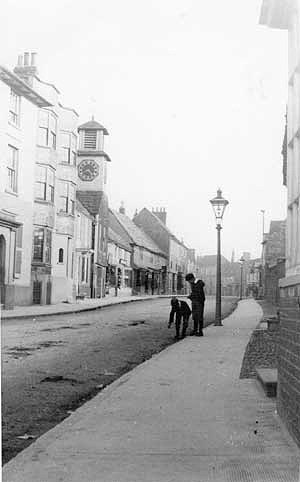
Steyning Museum archives - The King’s Highway
Steyning Museum has a copy of a parchment scroll going back to the period before the brief reign of Richard III.It has much to say about “the Kings Highway” which was how it described Steyning’s High Street. Originally a road claiming to be the King’s Highway was wide enough to allow sixteen knights to ride abreast but, by Edward V’s reign, it described nothing more than the main road.
Certainly there is nothing to suggest that sixteen knights ever trotted down the High Street. And, if they had, they would have discovered that it was not in particularly good repair. Where the road crossed the Fullersbrook (the stream which runs down past the Star) the state of the road was so bad that there was a danger “of great damage to all”. In 1461 Richard Jay and Peter Farnfold were “given a day to make it up” with a penalty of 40 pence each if they failed to do so. 40 pence was equal to 10 days pay for an agricultural labourer – so quite a large sum. But they weren’t unduly bothered.
Two years later, with no evidence of any fines having been paid, exactly the same problem was still being identified. When you add complaints of timber and dung heaps obstructing the King’s Highway on a regular basis you can see that keeping the road passable, let alone open for sixteen horsemen to ride down, was a continuing challenge.
Steyning was a market town and had been for many centuries so it is also not surprising that there are a good many records of animals getting loose. At the start of the 19th century, for instance, there is a newspaper report of a heifer getting loose and rampaging through the town before it was wrestled to the ground “by an athletic sack weaver”. The sounds, as men’s hobnailed boots struck sparks from the rough flint road surface, and the smells in the High Street must have been distinctive.
Some of the photographs of the High Street from the 1890’s show it as being nearly devoid of all signs of life. But that’s not entirely accurate. It was a playground for children. Girls skipped in the middle of the street and boys played marbles in the gutter.
It was also where much of Steyning’s public life was enacted. The weekly market and the twice yearly fairs filled the street with animals, farmers and crowds of onlookers. Parades to mark momentous occasions went from the Mouse Lane corner through the High Street to the Church. And, because one of the centres of the film industry in the early years of the 20th century was close by on Shoreham Beach, Steyning streets were used as stage sets and Steyning people became film extras. Taking part in the filming of “King Charles” in 1913 a Steyning mother recalled that, with the extra money, she was able to afford new shoes for her children for the first time.
In the 1900’s he Parish Council was very concerned about the High Street: when and for how long the gas lights should be lit; did the lamps need to be lit at all either side of the full moon; and should they should be turned off at 10 o’clock or 10.45. They discussed who should get the contract for watering the street to keep the dust down and then, in 1908, argued with the County Council over who should pay for the tarring of the road surface.
It all seems to be very reminiscent of the efforts to keep the road in good condition 500 years earlier – except that by 1908 the Parish Council was not worried about sixteen knights riding abreast. They, instead, were more concerned about motor vehicles and passed a resolution to set a speed limit of 10 miles an hour for cars travelling through the town.
And today? Our parking habits would have presented a significant challenge for those knights.

